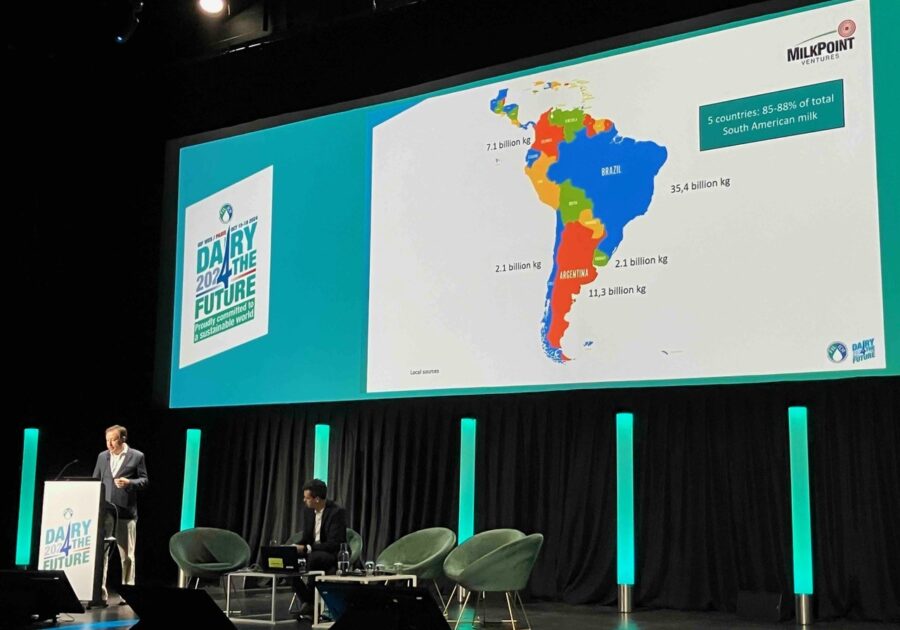Coming together at the World Dairy Summit

International Dairy Federation’s World Dairy Summit
An estimated 1,600 people travelled from 60 countries worldwide to participate in this year’s International Dairy Federation’s World Dairy Summit, held in Paris, France, according to its new director general, Laurence Rycken. It certainly had the feel of a United Nations of dairy, with the French organisers working overtime to ensure everyone had lots to think about in the sessions, devoted to everything from a global dairy leaders panel to labour challenges in the sector, to sustainability practices and the environment, to forecasts for the future. As Piercristiano Brazzale, the outgoing president of the organisation noted, “Dairy and livestock is not the problem, it is part of the solution to climate change.”
The possible solutions were examined. The moderator for the Wednesday morning (16 October) session on forecasting milk production and exports in the Americas noted in his introduction, “The world will need more milk, the appetite for milk globally growing and the world of milk is changing – it’s a very cruel planet.”
Marcelo Carvalho, CEO of MilkPoint Ventures in Brazil, examined how the South American dairy production was changing. South America’s statistics are that it contains five per cent of the world’s population, with 12 per cent of the total land, with 50 per cent being tropical, and amounting to nine per cent of the global cow milk output. “Uruguay is the New Zealand of South America, with a small population and a large milk production, with around 60 per cent exported,” he observed. “However, it is not a uniform region, and Brazil tops the list with a little over 308,000 specialised dairy farmers, who produced 34 million metric tons in 2022, according to MilkPoint estimates. The total share of global production for the region increased in 2010-11, and then reduced back to below where it was before. The issue of the region losing competitiveness is something that has happened in the last 10 years, with the main counties are not growing as they used to, he pointed out. “Overall, they have added two million litres in total, while the US, by contrast, added 12 million litres over the same timeframe,” Carvalho stated.
There have been many reasons for this: more intense climate change, deadly floods in south Brazil, labour competition with other agricultural areas and urban activities, and institutional aspects. These include farm policies, no government support, political uncertainty, and as 25 per cent of the producer base changes every year, it becomes difficult to have long term plans. Externally, the pandemic, the Russia-Ukraine war, international prices and China’s declining role in imports have all landed on the region as well.
On the domestic consumption side, it is an improving story. In Brazil, intake of milk has increased to 170 litres per person per year, from 120 litres, with a population of 200 million. There has been a large increase in farm size output, from 246kg per day to 437kg in 2023. This is growth of 77 per cent, but is still very small compared to other countries, he stated.
Cost is a challenge and since 2009, inflation has gone up, thus making farming expensive. Volatility continues to be the name of the game, but in countries such as Argentina, they are now working on fixing institutional factors. There are structural changes happening in South America, with small dairy companies going out of business, while the region overall will increase its imports.
Meanwhile, there is some work being done on the environment, as arable farms have realised that having animals is a way to reduce chemical fertiliser use. “Farmers are adapting many of the practices, so it’s a win/win – crop rotation, biologicals, biogas, solar power, and adapting trucks to use biomethane. The challenge is to have more farmers have access to that technology. Some companies are offering grants to help farmers upgrade. It is a huge opportunity to lead on this question, as COP 30 is being held in Brazil next year,” he stated. Unfortunately, for the region’s exports, they became more expensive for the market before they became good, he added.






